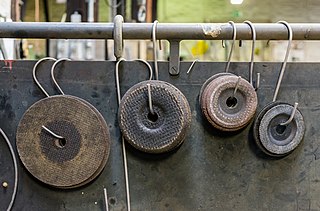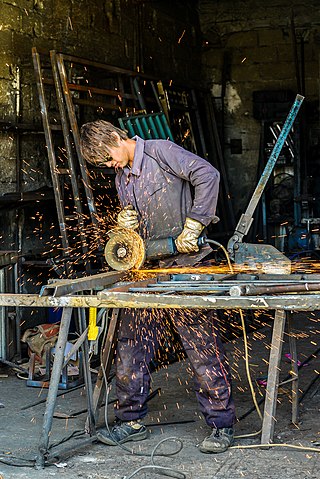
Metalworking is the process of shaping and reshaping metals in order to create useful objects, parts, assemblies, and large scale structures. As a term, it covers a wide and diverse range of processes, skills, and tools for producing objects on every scale: from huge ships, buildings, and bridges, down to precise engine parts and delicate jewelry.
An abrasive is a material, often a mineral, that is used to shape or finish a workpiece through rubbing which leads to part of the workpiece being worn away by friction. While finishing a material often means polishing it to gain a smooth, reflective surface, the process can also involve roughening as in satin, matte or beaded finishes. In short, the ceramics which are used to cut, grind and polish other softer materials are known as abrasives.

A bandsaw is a power saw with a long, sharp blade consisting of a continuous band of toothed metal stretched between two or more wheels to cut material. They are used principally in woodworking, metalworking, and lumbering, but may cut a variety of materials. Advantages include uniform cutting action as a result of an evenly distributed tooth load, and the ability to cut irregular or curved shapes like a jigsaw. The minimum radius of a curve is determined by the width of the band and its kerf. Most bandsaws have two wheels rotating in the same plane, one of which is powered, although some may have three or four to distribute the load. The blade itself can come in a variety of sizes and tooth pitches, which enables the machine to be highly versatile and able to cut a wide variety of materials including wood, metal and plastic. Band saw is recommended for use in cutting metal as it produces much less toxic fumes and particulates when compared with angle grinder and reciprocating saw.

A grinding machine, often shortened to grinder, is a power tool used for grinding. It is a type of machining using an abrasive wheel as the cutting tool. Each grain of abrasive on the wheel's surface cuts a small chip from the workpiece via shear deformation.

A mandrel, mandril, or arbor is a tapered tool against which material can be forged, pressed, stretched or shaped, or a flanged or tapered or threaded bar that grips a workpiece to be machined in a lathe. A flanged mandrel is a parallel bar of a specific diameter with an integral flange towards one end, and threaded at the opposite end. Work is gripped between the flange and a nut on the thread. A tapered mandrel has a taper of approximately 0.005 inches per foot and is designed to hold work by being driven into an accurate hole on the work, gripping the work by friction. A threaded mandrel may have a male or female thread, and work which has an opposing thread is screwed onto the mandrel.

The phrase speeds and feeds or feeds and speeds refers to two separate velocities in machine tool practice, cutting speed and feed rate. They are often considered as a pair because of their combined effect on the cutting process. Each, however, can also be considered and analyzed in its own right.

Grinding wheels are wheels that contain abrasive compounds for grinding and abrasive machining operations. Such wheels are also used in grinding machines.
A grinding dresser or wheel dresser is a tool to dress the surface of a grinding wheel. Grinding dressers are used to return a wheel to its original round shape, to expose fresh grains for renewed cutting action, or to make a different profile on the wheel's edge. Utilizing predetermined dressing parameters will allow the wheel to be conditioned for optimum grinding performance while truing and restoring the form simultaneously.

A Tool and Cutter Grinder is used to sharpen milling cutters and tool bits along with a host of other cutting tools.

Knife making is the process of manufacturing a knife by any one or a combination of processes: stock removal, forging to shape, welded lamination or investment cast. Typical metals used come from the carbon steel, tool, or stainless steel families. Primitive knives have been made from bronze, copper, brass, iron, obsidian, and flint.

The English wheel, in Britain also known as a wheeling machine, is a metalworking tool that enables a craftsperson to form compound curves from flat sheets of metal such as aluminium or steel.

Polishing and buffing are finishing processes for smoothing a workpiece's surface using an abrasive and a work wheel or a leather strop. Technically, polishing refers to processes that uses an abrasive that is glued to the work wheel, while buffing uses a loose abrasive applied to the work wheel. Polishing is a more aggressive process, while buffing is less harsh, which leads to a smoother, brighter finish. A common misconception is that a polished surface has a mirror-bright finish, however, most mirror-bright finishes are actually buffed.

A diamond tool is a cutting tool with diamond grains fixed on the functional parts of the tool via a bonding material or another method. As diamond is a superhard material, diamond tools have many advantages as compared with tools made with common abrasives such as corundum and silicon carbide.

A die grinder or rotary tool is a handheld power tool and multitool used for grinding, sanding, honing, polishing, or machining material. All such tools are conceptually similar, with no bright dividing line between die grinders and rotary tools, although the die grinder name tends to be used for pneumatically driven heavy-duty versions whereas the rotary tool name tends to be used for electric lighter-duty versions. Flexible shaft drive versions also exist.

The cylindrical grinder is a type of grinding machine used to shape the outside of an object. The cylindrical grinder can work on a variety of shapes, however the object must have a central axis of rotation. This includes but is not limited to such shapes as a cylinder, an ellipse, a cam, or a crankshaft.

Grinding is a type of abrasive machining process which uses a grinding wheel as cutting tool.
Electrochemical grinding is a process that removes electrically conductive material by grinding with a negatively charged abrasive grinding wheel, an electrolyte fluid, and a positively charged workpiece. Materials removed from the workpiece stay in the electrolyte fluid. Electrochemical grinding is similar to electrochemical machining but uses a wheel instead of a tool shaped like the contour of the workpiece.
Surface grinding is done on flat surfaces to produce a smooth finish.

A disc cutter is a specialised, often hand-held, power tool used for cutting hard materials, ceramic tile, metal, concrete, and stone for example. This tool is very similar to an angle grinder, chop saw, or even a die grinder, with the main difference being the cutting disc itself. This tool is highly efficient at cutting very hard materials, especially when compared to hand tools.
Grinding wheel wear is an important measured factor of grinding in the manufacturing process of engineered parts and tools. Grinding involves the removal process of material and modifying the surface of a workpiece to some desired finish which might otherwise be unachievable through conventional machining processes. The grinding process itself has been compared to machining operations which employ multipoint cutting tools. The abrasive grains which make up the entire geometry of wheel act as independent small cutting tools. The quality, characteristics, and rate of grinding wheel wear can be affected by contributions of the characteristics of the material of the workpiece, the temperature increase of the workpiece, and the rate of wear of the grinding wheel itself. Moderate wear rate allows for more consistent material size. Maintaining stable grinding forces is preferred rather than high wheel wear rate which can decrease the effectiveness of material removal from the workpiece.
















